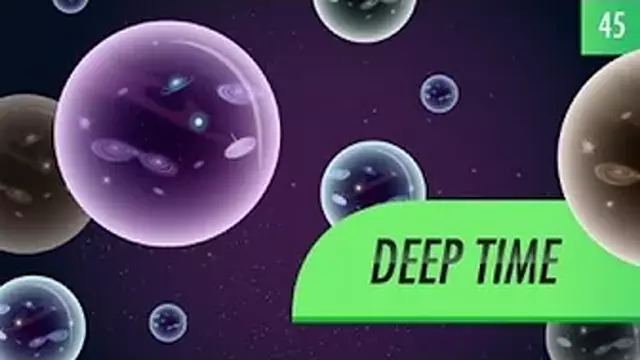2016-01-14
[public] 2.03M views, 39.4K likes, 773 dislikes audio only
As we approach the end of Crash Course Astronomy, it’s time now to acknowledge that our Universe’s days are numbered. Stars will die out after a few trillion years, protons will decay and matter will dissolve after a thousand trillion trillion trillion years, black holes will evaporate after 10^92 years, and then all will be dark. But there is still hope that a new Universe will be born from it.
Check out the Crash Course Astronomy solar system poster here: http://store.dftba.com/products/crashcourse-astronomy-poster
If you want to learn more about the creation and death of the universe, watch Crash Course Big History here: https://youtube.com/playlist?list=PL8dPuuaLjXtMczXZUmjb3mZSU1Roxnrey
--
Chapters:
Introduction: The End of the Universe 00:00
Scientific Notation 1:34
The Five Ages of the Universe 2:20
The Primordial Era 2:52
The Stelliferous Era (You Are Here!) 3:05
The Degenerate Era 4:48
The Black Hole Era 7:42
The Dark Era 9:39
The Big Rip 10:20
Other Possibilities: Multiverses & The Cosmic Reboot 11:52
Review 14:10
--
PBS Digital Studios: http://youtube.com/pbsdigitalstudios
Follow Phil on Twitter: https://twitter.com/badastronomer
Want to find Crash Course elsewhere on the internet?
Facebook - http://www.facebook.com/YouTubeCrashCourse
Twitter - http://www.twitter.com/TheCrashCourse
Tumblr - http://thecrashcourse.tumblr.com
Support CrashCourse on Patreon: http://www.patreon.com/crashcourse
--
Hawking Radiation Mechanism resources:
https://en.wikipedia.org/wiki/Hawking_radiation
http://math.ucr.edu/home/baez/physics/Relativity/BlackHoles/hawking.html
http://casa.colorado.edu/~ajsh/hawk.html
PHOTOS/VIDEOS
Hubble ACS SWEEPS Field http://hubblesite.org/gallery/album/star/star_field/pr2011016b/ [credit: NASA, ESA, W. Clarkson (Indiana University and UCLA), and K. Sahu (STScI)]
Flare http://www.nasa.gov/sites/default/files/thumbnails/image/dg_cvn_flare_final_4k_0.jpg [credit: NASA's Goddard Space Flight Center/S. Wiessinger]
Hubble Views Stellar Genesis in the Southern Pinwheel http://hubblesite.org/newscenter/archive/releases/2014/04/image/a/ [credit: NASA, ESA, and the Hubble Heritage Team (STScI/AURA)]
White Dwarf http://www.nasa.gov/multimedia/imagegallery/image_feature_468.html [credit: NASA, ESA, H. Bond (STScI) and M. Barstow (University of Leicester)]
Neutron Star Illustrated https://commons.wikimedia.org/wiki/File:Neutron_star_illustrated.jpg [credit: NASA, Casey Reed - Penn State University]
Black Holes: Monsters in Space http://www.nasa.gov/mission_pages/nustar/multimedia/pia16695.html [credit: NASA/JPL-Caltech]
Binary Neutron Star Video https://nasaviz.gsfc.nasa.gov/vis/a030000/a030500/a030569/slide_04-B3_CWDB_inspiral.mp4 [credit: NASA]
Giant Elliptical Galaxy NGC 1316 in Fornax Cluster https://www.eso.org/public/images/eso0024a/ [credit: ESO]
Proton Aurora http://svs.gsfc.nasa.gov/cgi-bin/details.cgi?aid=20099 [credit: NASA/Goddard Space Flight Center Conceptual Image Lab]
A Race Round a Black Hole http://www.nasa.gov/centers/goddard/universe/blackhole_race.html [credit: NASA/Dana Berry, SkyWorks Digital]
The Big Bang http://svs.gsfc.nasa.gov/cgi-bin/details.cgi?aid=10128 [credit: NASA]
Hubble Ultra Deep Field 2014 http://hubblesite.org/newscenter/archive/releases/2014/27/image/a/ [credit: NASA, ESA, H. Teplitz and M. Rafelski (IPAC/Caltech), A. Koekemoer (STScI), R. Windhorst (Arizona State University), and Z. Levay (STScI)]
Galaxy http://apod.nasa.gov/apod/ap150614.html [credit: Subaru Telescope (NAOJ), Hubble Space Telescope, Robert Gendler]
One star, many stars (M13) http://www.deepskycolors.com/archive/2011/05/04/one-star-many-stars-M13.html [credit: Rogelio Bernal Andreo]
Earth https://www.nasa.gov/content/goddard/earth-from-space-15-amazing-things-in-15-years [credit: NASA's Earth Observatory]
Explosion video [credit: Shutterstock / Richard Finch]
youtube.com/watch?v=ZnOTprOTHc8
http://store.dftba.com/products/crashcourse-astronomy-poster
/youtube/video/jDF-N3A60DE?t=0
/youtube/video/jDF-N3A60DE?t=94
/youtube/video/jDF-N3A60DE?t=140
/youtube/video/jDF-N3A60DE?t=172
/youtube/video/jDF-N3A60DE?t=185
/youtube/video/jDF-N3A60DE?t=288
/youtube/video/jDF-N3A60DE?t=462
/youtube/video/jDF-N3A60DE?t=579
/youtube/video/jDF-N3A60DE?t=620
/youtube/video/jDF-N3A60DE?t=712

